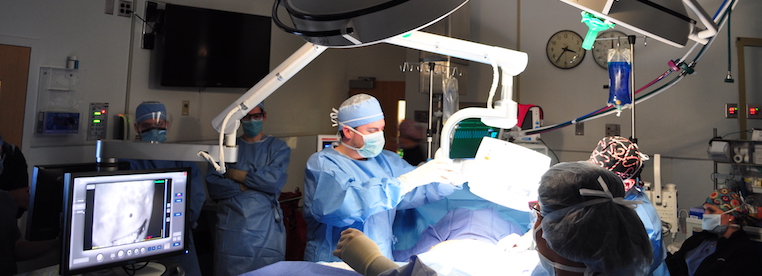Sarah Bessin, a 47-year-old breast cancer survivor, received her diagnosis in July 2015. In October, Bessin opted to begin breast reconstruction at the same time as her mastectomy. The team at MedStar Georgetown University Hospital was able to save Bessin’s breast tissue and improve her breast reconstruction outcome through the unique combination of the following two tissue-saving technologies to diagnose and avoid serious complications:
- The SPY Elite fluorescent imaging system that gives breast surgeons and plastic surgeons the ability to assess the quality of blood flow in the breast tissue in order to make the critical decision on whether to insert implants immediately or wait.
- Hyperbaric oxygen therapy to facilitate the healing process.
“My surgeon told me he would decide during surgery whether or not I could undergo breast reconstruction immediately, but I’m so glad he decided to wait before proceeding with implants. It gave me a chance to heal, and the results of my reconstruction are just remarkable,” Bessin shared.
“Everything that we do in plastic surgery involves blood flow. If blood flow is disrupted, the overlying skin can die. This is the reason we need to be able to anticipate these problems intraoperatively so we can act quickly,” said Troy Pittman, MD, Bessin’s breast reconstruction surgeon.
SPY Elite: A New Valuable Player in the Operating Room
After a mastectomy, the plastic surgery team enters the operating room with a fluorescent imaging system called SPY Elite. SPY Elite has a long arm that connects to an infrared lamp device, which is used for scanning over a patient’s body. A special contrast is injected through the patient’s IV line, and a TV monitor shows the scans of breast tissue and blood vessels in real time.
A breast reconstruction surgeon will move the SPY Elite lamp over different areas of the breast to detect the quality of blood flow in breast tissue before proceeding with the surgery. The system’s monitoring of the blood flow helps surgeons determine if the patient’s tissue is in a safe state to move forward with surgery and place an implant.
If blood flow is limited, surgeons will add hyperbaric oxygen therapy after surgery to promote healing in the tissue.
“SPY Elite lets me look at the blood supply of the breast tissue and the nipple in real time,” Dr. Pittman said. “This helps us diagnose a problem early on and initiate hyperbaric oxygen therapy within 24 hours, if we need to.”
SPYing a Problem During Bessin’s Procedure
During Bessin’s procedure, the SPY Elite imaging system informed Dr. Pittman’s team that there were worrisome vascular changes in her breast skin following the mastectomy. To avoid compromising the vascular health of the skin, Dr. Pittman decided on a different plan.
The new breast reconstruction approach for Bessin meant waiting on the implants and placing tissue expanders, a type of deflated temporary implant, in the surgery site. This plan allows for healing time in the hyperbaric oxygen therapy chamber.
“Our goal is to get patients in for treatment as soon as possible. We are aggressively treating the patient to save their breast tissue and augment their healing,” said Kelly Johnson-Arbor, MD, medical director of Hyperbaric Medicine in the Department of Plastic Surgery. “Our dedicated team of physicians, nurses and technicians work to ensure that patients remain safe and comfortable during their treatment regimen.”
Healing Tissue Within Days with Hyperbaric Oxygen Therapy
Hyperbaric oxygen therapy exposes patients to pure oxygen in a pressurized space. Sending patients to the hyperbaric oxygen chamber treats the initial blood flow issue and can help the patient avoid future healing problems. Treatment begins within 24 hours after surgery and does not require patients to stay in the hospital.
Bessin’s tissue healed in only 13 hyperbaric oxygen therapy treatments. Her hyperbaric oxygen therapy schedule began with two visits to the hospital per day, which later decreased to one visit per day near the end of her treatment.
“I bounced back quite quickly. I’m already working my normal schedule, and my energy level is back to normal,” Bessin shared. “I’m so grateful to my doctors for providing this therapy!”
Hyperbaric Oxygen Therapy: Rest and Relaxation Time
Bessin recalled that she spent most of her time relaxing in the hyperbaric oxygen therapy chamber, which is a large glass tube. In the chamber, patients cannot wear makeup, lotion, nail polish or outside clothing, nor can they bring in a cellphone, books or paper. A glass of water and a cotton gown are permitted inside the chamber. During treatment, a nurse or technician stays in the room the whole time to administer the hyperbaric oxygen therapy, answer questions or assist with movie selections.
“Georgetown has a great movie selection,” Bessin pointed out.
Access for Every Breast Reconstruction Patient at MedStar Georgetown
Dr. Pittman has used SPY Elite with hyperbaric oxygen therapy at MedStar Georgetown for five years. For breast reconstruction, Dr. Pittman’s team uses SPY Elite on almost every patient, but particularly in those who want to begin breast reconstruction with an implant immediately after a mastectomy.
“SPY Elite and hyperbaric oxygen therapy allow us to aggressively treat patients safely and predictably,” said. Dr. Pittman. “This approach gives our patients the best chance for success.”
To date, MedStar Georgetown University Hospital is the only center in the greater Washington, D.C., region to offer both SPY Elite and hyperbaric oxygen therapy for patients with breast cancer.

